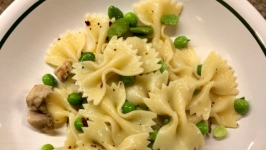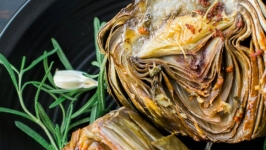Silicon Valley Orchardists 2.0
Transformational Growers of Silicon Valley
South of San Francisco lies an achingly beautiful region, where redwoods once graced the hills and early missionaries were astonished to find grapes, scented rosemary and bright yellow sunflowers growing wild. Things bloomed here, seemingly without cultivation, because the growing season was long and mild, and the rich loam of the mountains had been washing down onto the land for eons, creating some of the richest topsoil in the world.
When miners flocked to California in 1849, only a few made their fortunes in gold. Many more hiked down the Sierras and stumbled into San Jose en route home. Some, eyeing the fragrant fruit in the nearby mission gardens, sent home for seedlings. The era of the first orchard entrepreneurs was born.
By 1890, the San Francisco Peninsula and its nearby counties were shipping millions of pounds of apricots, prunes, peaches and cherries across the United States and around the world. At its peak, in the years between the two world wars, the region was, in aggregate, the largest commercial orchard in the world. Tourists flocked to the orchards in the spring, just to picnic amid the blossoms.
It was the Cold War that turned the focus from farm tech to high tech. The population began doubling every decade and orchard land became ripe for development. By 1964, with the number of growers down by 90%, the sons and daughters of the orchards turned to real estate and technology to make their fortunes.
Yet some still walked the dusty land as the summer sun ripened their apricots, plums and cherries. And some endured, to reimagine the orchards of the 21st century.
Jim Salyards
Filoli, Woodside
Jim Salyards can look out his windows as the light falls along the foothills and see wild foxes trot by on their nightly rounds. Salyards is head of horticulture at Filoli, the National Trust for Historic Preservation estate in Woodside, and one of the perquisites of his job is living on the property.
Among his prime priorities is the Filoli Gentlemen’s Orchard, restored over the last two decades. With growing interest in the food movement in the Bay Area, it is now one of Filoli’s top attractions.
It almost didn’t survive. The builder of the estate, Gold Rush heir William Bourn, began planting in the early 20th century. Styled after the orchards of Thomas Jefferson and others, it was dubbed the Gentlemen’s Orchard since it was planted at a time when only a gent could afford such luxury. Though stewardship continued under owners William and Lurline Matson Roth, by the 1970s the orchard was overgrown with poison oak.
Beginning in 1997, with donations from the California Rare Fruit Growers, Filoli’s gardeners went to work. The orchard now boasts rare apples with names such as Cinnamon Spice and Winter Banana, along with 272 other varieties. There are 59 kinds of pears—including the otherwise-extinct Colonel Dearborn, found among the weeds in 1998. There are 42 varieties of peaches, 11 more of nectarines, three apricot trees, 15 walnut, nine quince and six ancient medlar—a fruit so old its origins are unknown.
“We’re not only restoring,” says Salyards. “We are also preserving lost varieties. And we’re teaching everyone who comes here about raising fruit.”
Best of all, preservation has led to preserves. Filoli’s fruits can now be enjoyed year-round through the estate’s brand of fruit butters, honeys and jams. They are the next best thing to having a gentlemen’s orchard out your own back door.
Deborah Olson and Charles Olson
C.J. Olson Cherries, Sunnyvale
Deborah Olson has managed her family’s farm stand for more than three decades, bringing the best of first-rate, sustainable local produce— especially cherries and apricots—to her many customers. It is a continuation of a family business begun in 1899 when Carl Olson and his bride, Hannah, moved to Sunnyvale and bought five acres of orchard land for the princely sum of $150 an acre.
It has not been without its challenges. In 1999, the family made the difficult decision to develop its cherry orchard—one of the last on bustling El Camino Real. Though Olson and her father, Charles Olson, preserved its historic tank house, incorporating it into the new stand, they faced a backlash.
“People told me they were angry our orchard was gone—even though my father was still growing fruit around the corner,” she says. While her customers stewed, Olson, who by then had earned a culinary diploma in Paris, developed a global strategy.
She sought out the best cherries in the Western Hemisphere—from the Pacific Northwest to as far south as Chile—lengthening her season. Then, she raised her profile, making television appearances with Martha Stewart, Julia Child and Jacques Pepin, promoting her fruit and her recipe for pie. Along with her annual festival and cherry pit spitting contest (record: 35 feet!) she and her partner, Jean-Pierre Labari, won back their market and more. They now operate the main store and two satellites, at Mineta San Jose and Oakland International airports.
Sunnyvale native and NBC Bay Area reporter Robert Handa calls Deborah Olson a local icon. “My family and friends stay loyal to C.J. Olson,” he says. “Its hometown atmosphere is reassuring in an increasingly developed Sunnyvale.”
Olson beams. “Orchards will always be part of our lives,” she says. “After all, people will always have to eat.”
Andy Mariani
Andy’s Orchard, Morgan Hill
Andy Mariani loves to call himself “just a poor dirt farmer,” but few who have met him and tasted his scented Blenheims or his Silk Road nectarines are fooled. This focused entrepreneur earned his master’s degree from the University of Southern California, is a member of the California Cherry Advisory Board’s research committee and is a contributing writer to the Oxford Encyclopedia of Food and Drink in America.
This scholar-farmer hybrid truly loves what he does—and so do his customers. His commitment to quality has transformed his business from fruit as a commodity, priced by the ton, to fruit as a specialty, valued for its flavor. His cultivation of heirloom varieties from as far away as Uzbekistan has brought him renown. David Kinch, owner of the Michelin-starred Manresa in Los Gatos, says of Mariani’s delicate white Afghanistan apricot, “It is like eating a cloud.”
Andy Mariani is the grand-nephew of Paul Mariani, founder of the Mariani Packing Company, established among the orchards near San Jose a century ago. His father, Joseph, arrived a generation later, moving to the present acreage in Morgan Hill in 1957. It was at family gatherings that Mariani learned his Uncle Paul’s secret for keeping dried fruit moist and plump—a recipe he still uses today.
As the years went by, Mariani watched as the mass production of fruit in California created greater quantities with less distinction. That is where he found his niche. In the 1980s, he opened his own stand and began both direct marketing and the cultivation of rare stone fruits. His annual tastings at Andy’s Orchard now attract crowds who savor his samples and descend on his orchards for his docent-led tours.
His fruits are “melt-in-your-mouth exemplars of nature’s candy,” says Chef Bruno Chemel of the Michelin-starred Baumé in Palo Alto. “They bring back memories of my childhood in France.” To many, they bring back the true taste of California.
Though tech gets most of the ink, agriculture continues to thrive in both Santa Clara and San Mateo counties. In Santa Clara County, agricultural production rose to $279 million in 2015. A recent study by the University of California, Davis, shows its ancillary value adds another $832 million annually to the local economy. Growers face challenges with both labor and water, as they do all over California, but the industry is working hard to overcome both as entrepreneurs continue to find benefits, farming on the urban fringe.
Orchards have long had a mysterious connection with some of Silicon Valley’s most famous. Both David Packard and Steve Jobs cultivated apricot orchards adjacent to their homes, long after they became billionaires. Blueprints for the new Apple campus in Cupertino include apricot and apple trees on the futuristic site. Perhaps it isn’t happenstance that Jobs’ famous company was named after the fruit of an orchard tree.
Silicon Valley's visionaries knew, years ahead of the rest of the country, it is important to stay connected to the things we can grow. As the region continues its streak of wonderous inventions, a single piece of fresh fruit for a sunny orchard has yet to be supplanted as the sweetest, and most sustainable, hand-held delight on planet Earth.





